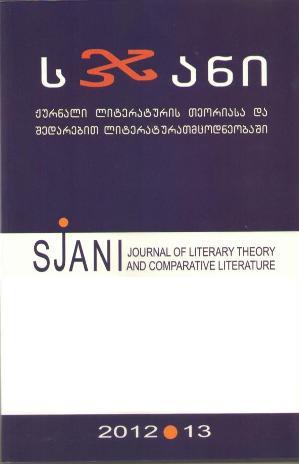Легенда, миф, символ: дефиниция явления в контексте развития драматургии и театра в Литве
The Legend, Myth, Symbol: Definition of the Phenomenon in the Context of Dramarurgys’s and Theatre’s Development in Lithuania
Author(s): Vida BakutytėSubject(s): Literary Texts
Published by: ლიტერატურის ინსტიტუტის გამომცემლობა
Keywords: myth; legend; symbol; lithuanian language; lithuanian dramaturgy; folklore.
Summary/Abstract: The attempts to use a legend, myth or symbol as a reference point in the Lithuanian dramaturgy and theatre has its pre-history, which often becomes a matter of controversy. This phenomenon is partially linked with the development of the national and cultural identity. Indicative in this respect is the period when both Lithuania and Georgia were part of the czarist Russian Empire at the same time in history. Lithuania and Georgia are linked by a number of cultural ties: the Caucasus topic was used in the Lithuanian literature and art. However, the development of literature and dramaturgy in the native language in Lithuania and Georgia has certain differences. When the famous Georgian writer Vazha- Pshavela gained recognition in the world of literature (around 1881), the Lithuanian printed word, with its origins dating back to the 16th century, and the Lithuanian language, being one of the oldest Indo-European languages, faced the oppression of Polonization and Russification from the 18th century onwards. With such historical circumstances in mind, we have to speak about two different contexts of development of literature and theatre in Lithuania and different definitions of the topic under analysis relating to it. The use of a Lithuanian myth or a legend in the dramaturgy written in other than Lithuanian language (19th century) and their use upon the restoration of the freedom of the Lithuanian word are two different cases loaded with peculiar aspects. The baggage of the means of artistic expression used by the Polish Romantics in Lithuania in the 19th century included a number of Lithuanian words and characters from the Lithuanian mythology, which used to acquire a symbolic meaning and render archaic characteristics. The master of mythological mindset Józef Ignacy Kraszewski wrote his trilogy Anafielas with reference to the ancient Lithuanian mythology and named it after the songs from the Lithuanian legends. We may draw certain analogies between the first part of the trilogy by Kraszewski titled Lament of Vitolis and Giglia by Vazha- Pshavela (Lithuanian poet Jonas Graičiūnas, born in Tbilisi in 1903, translated Giglia into Lithuanian in 1977). The characters of the two works – a Lithuanian Ramojus and a Georgian Giglia – are warriors: the descriptive narratives and the scenes picturing the laments of their families bear certain resemblances. With the music written by the Polish composer Stanisław Moniuszko, who maintained his residence in Lithuania for some two decades, three cantatas Milda, Nijoła and Krumine were based on the afore-mentioned plot line from the Lithuanian mythology. The texts (writing in Polish) of the cantatas contain a number of Lithuanian-Samogitian words evolving into symbols.
Journal: სჯანი
- Issue Year: 2012
- Issue No: 13
- Page Range: 258-269
- Page Count: 12
- Language: Russian

